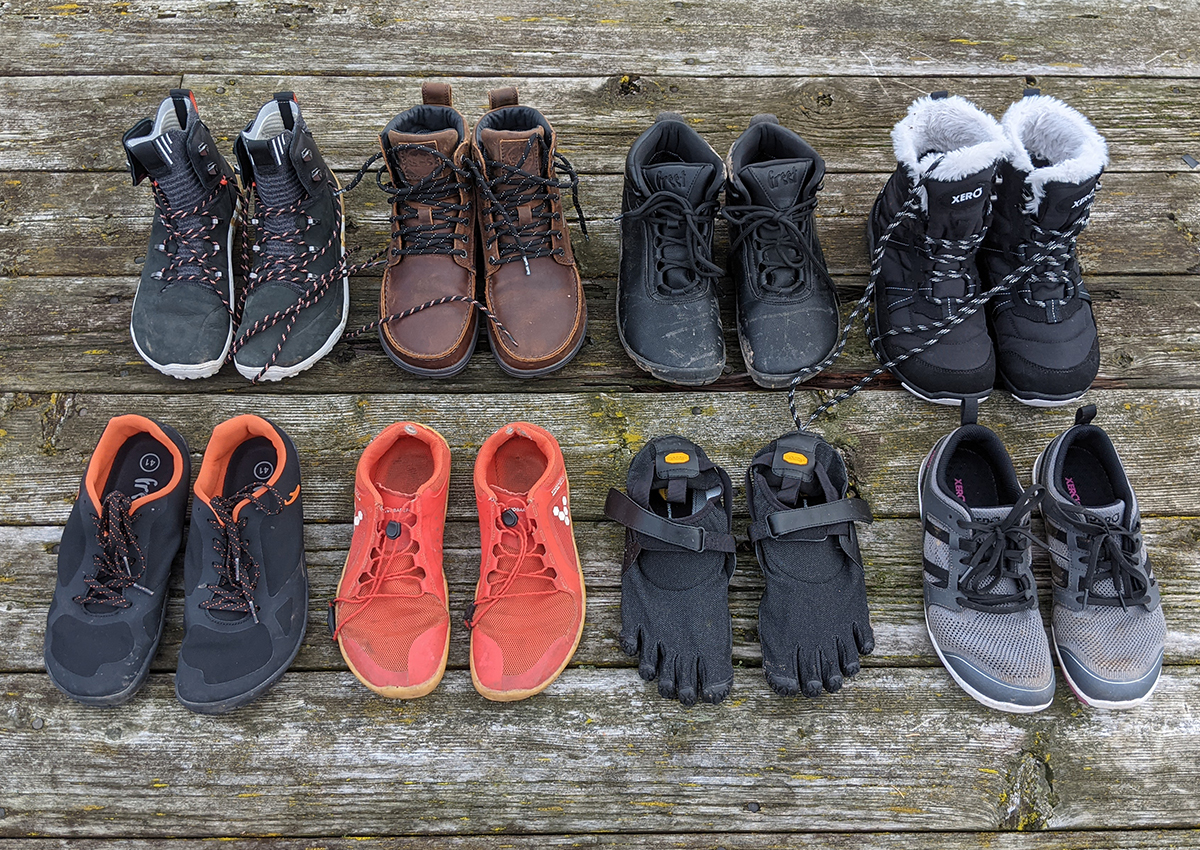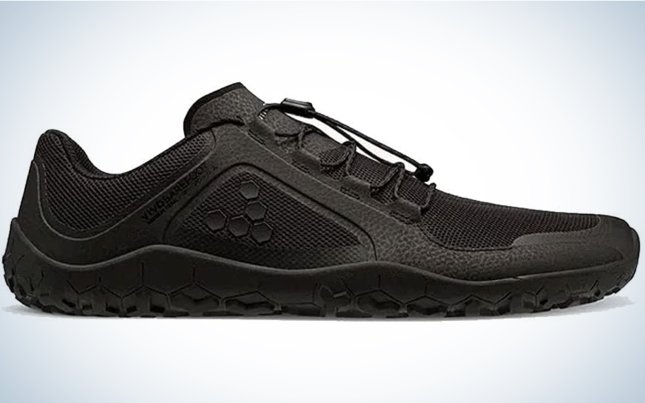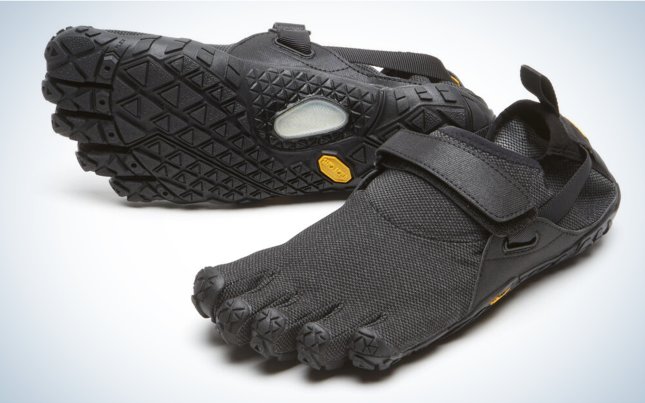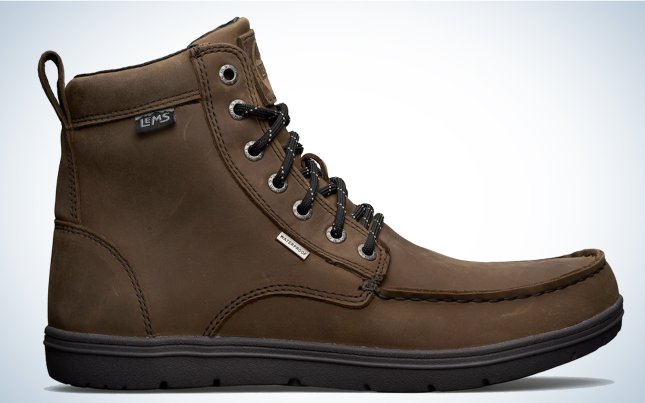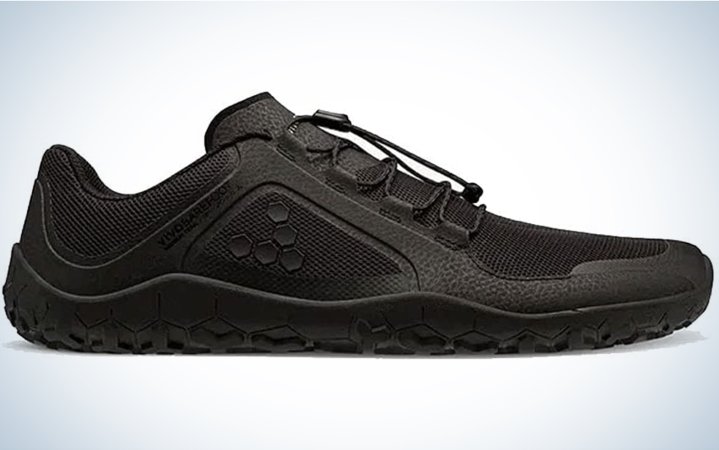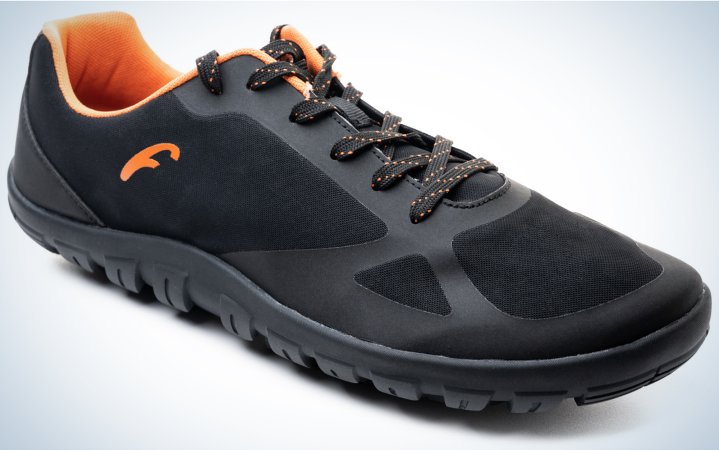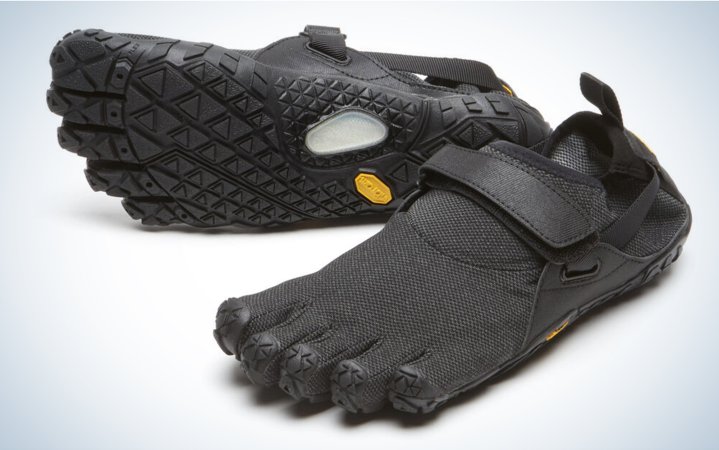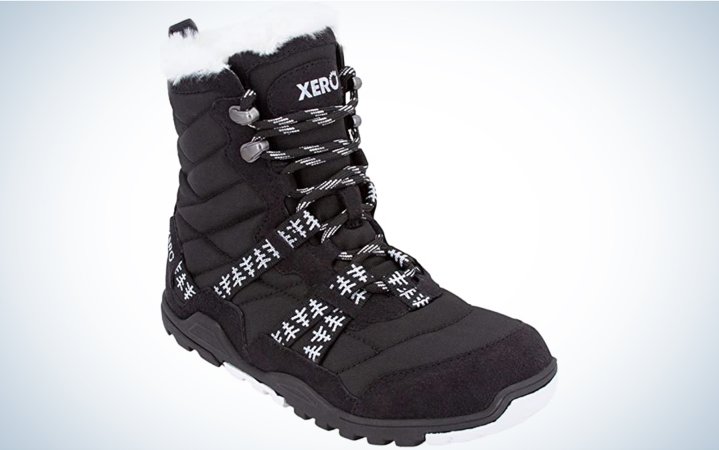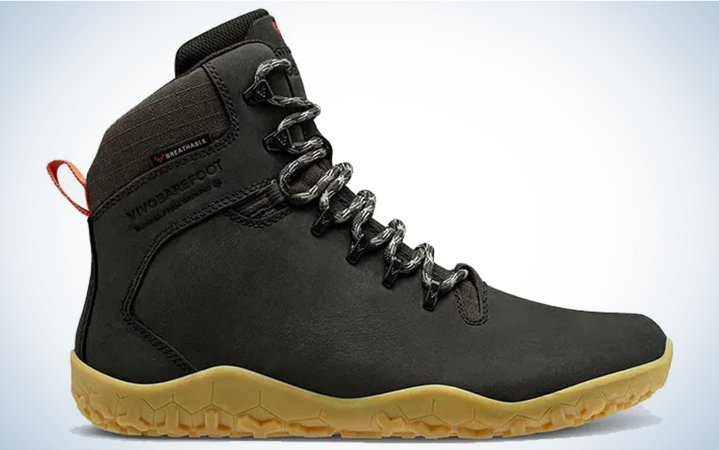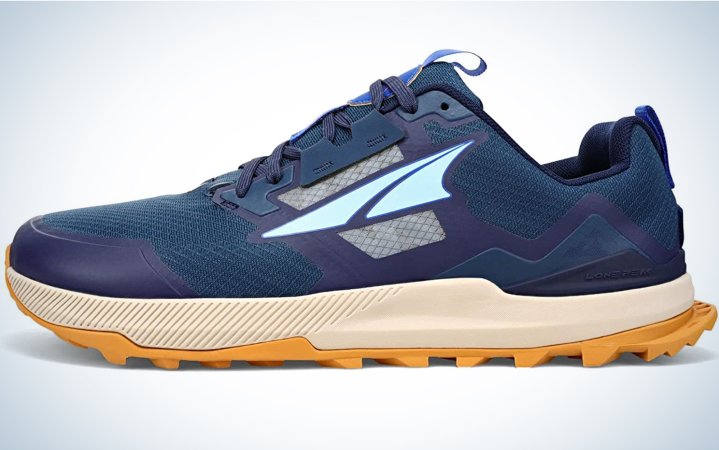We may earn revenue from the products available on this page and participate in affiliate programs. Learn More ›
For many hikers and trailer runners, freedom means landing confidently on the balls of their feet as they fly down a trail or trek deep into the forest with nary an extra ounce weighing them down. But with so few shoe manufacturers focusing on minimalist shoes, it’s hard to find ones that are up for tackling the toughest trails. To separate trail-wear from street-wear, we checked out models from Xero Shoes, Vibram, Freet, Lems, and Vivobarefoot to find the best minimalist shoes for hiking and trail running.
- Best Overall: Vivobarefoot Primus Trail II FG
- Best for Wide Feet: Freet Feldom
- Best Ground Feel: Vibram Spyridon EVO
- Best for Snow: Xero Shoes Alpine
- Best for Shoulder Seasons: Vivobarefoot Tracker
- Best Waterproof: Lems Boulder Waterproof
- Best for Beginners: Altra Lone Peak 7
How I Tested the Best Minimalist Shoes for Hiking and Trail Running
I’ve been hiking, trail running, and backpacking in minimalist shoes for over a decade, racking up thousands of miles over all kinds of terrain, from scorching desert to high-alpine snow, pine-needle cushioned forests to pumice. I’ve carried loads in excess of 30 pounds up thousands of vertical feet (and back down again), covering as many as 25 miles per day. Over time, I’ve developed an understanding of the challenges minimalist footwear faces on the trail.
For this test, I only looked at minimalist shoes with a zero heel drop and a stack height under 10mm, which included models from Xero Shoes, Freet, Vivobarefoot, Vibram, and Lems. I then took each pair on everything from day hikes to trail runs to overnight backpacking trips, in conditions ranging from snow to rain to mud. I evaluated each shoe for its ability to perform in different conditions, as well as its ground feel, fit, traction, and durability. Finally, I submerged each shoe in water to see either how long it took to dry (the trail runners) or to test waterproofness (the hiking boots).
Minimalist Trail Runners

Minimalist Hiking Boots

What to Consider Before Buying Minimalist Shoes
Your Experience
If this is your first pair of minimalist shoes then it’s worth taking a few moments to consider your running gait. Do you prefer a barefoot feel over something that locks your feet into place when you hike? When you run without shoes on, are you able to switch from a heel strike to a mid-foot or fore-foot strike? Minimalist shoes aren’t for everyone, and having a sense in advance of how your feet will manage the transition can help ensure a better experience.
Transitioning to minimal footwear can take time to adjust. Many people (myself included) will find that they need to significantly cut back on their mileage at first while their feet strengthen—the first couple of weeks I was running in Vibram Fivefingers I could barely run more than a quarter mile before the arch of my feet needed a break. Do not purchase your first pair of minimalist footwear right before a big trip.
Heel Drop
The heel drop of a shoe refers to the height differential between the toe of the shoe and the heel of the shoe. Minimalist shoes have (or at least should have) a zero heel drop, as any kind of raised heel in a shoe is going to promote heel striking.
Stack Height
Stack height refers to the height of the shoe under the sole. Many non-minimalist trail runners will have stack heights upwards of 35mm, and promote the cushion and comfort of the shoe. Minimalist trail runners, on the other hand, have a low stack height—for this story, I only considered shoes with a stack height under 10mm. A low stack height is necessary for ground feel, which allows your foot (and lower body) to adjust to the contours of the ground on your walk or run.
Lugs
Whereas the sole of your road running shoes might be only a few millimeters thick, many trail running shoes have hefty lugs for additional traction.

The best minimalist shoes for hiking and trail running do need to have substantial lugs to help you grip slippery trail surfaces, even though that will result in a hit to your overall ground feel.
Ankle Support
Worried about the comparative lack of ankle support in some of the minimalist trail runners and hikers? Don’t be: It’s nearly impossible to roll your ankle in a shoe with a low stack height, and, in reality, the flexible high-tops on most traditional hiking boots are not protecting your feet from rolling anyway.
Toe Splay
Some, but not all, minimalist shoes have wide toe boxes, to allow your toes to splay while you run. The idea here is that your foot will have greater stability on the ground with a wider surface area, and that your toes can respond better to the contours of the ground (which can have biomechanical effects on your ankle, knee, and hip) if they have room to spread.
Sizing
If you’re purchasing a minimalist trail runner or boot for the first time, it’s recommended that you size up a half size from your typical shoe size—I’ve indicated in the above tables when you may want to consider sizing up even more than that.
Best Minimalist Shoes for Hiking and Trail Running: Reviews & Recommendations
Best Trail Runner: Vivobarefoot Primus Trail FG II
Vivobarefoot Primus Trail FG II
Pros
- Substantial lugs provide plenty of durability
- Durable (for a trail runner)
Cons
- Expensive
Key Features
- Sizes: Men’s: 7-15; women’s: 5.5-11.5
- Stack Height: 6.5mm
- Weight: 15.8 ounces for a women’s 9
- Fits true to size
I’ve worn the Vivobarefoot Primus Trail FG for years, including on the Colorado Trail, and after testing models from other brands it’s still my go-to choice. It wasn’t the most comfortable (that’d be the Freet Felfdom); it didn’t have the best ground feel (Vibram Spyridon EVO) and wasn’t even the shoe I noticed the least while wearing (the Xero Zelen), but it had the best balance of these qualities, along with a few others that ended up pushing it over the finish line.

The first is that the contour of the shoe both holds my foot firmly in place while giving my toes plenty of room to move around. Next is that the 4mm height with 2.5mm lugs hits the sweet spot of traction and ground feel for a variety of terrains. I also appreciate the durability of the Vivobarefoot Primus FG: In my experience, the upper can handle over 800 miles easily—the first part of this shoe that is going to give out is the sole. My only complaint about these shoes is that they are significantly more expensive than other minimalist shoes (closer to higher end trail runners).
Having used Vivobarefoot shoes for years, I can attest that earlier versions of the shoe were fairly stiff, with insufficient volume on the interior of the shoe. However, more recent versions of this shoe are somewhat roomier (I still always take out the insole), and reasonably malleable out of the box, at least considering their durability. A few hikes or trail runs to break this one in won’t hurt, but you can head out on that big trip with a fresh pair without issue.
Best for Wide Feet: Freet Feldom
Freet Feldom
Pros
- Great fit for wider feet
- Comfortable
- Good traction
Cons
- Runners with standard or narrow feet may find that this shoe slips around
Key Features
- Sizes: Men’s: 7-13; women’s: 6-11.5
- Stack Height: 8mm
- Weight: 15.6 ounces for a women’s 9
- Runs wide
The Freet Feldom was by far the widest shoe that I tested. It was so wide, in fact, that even with the laces cinched down as far as they would go I could still easily shift my foot—which is a standard width—from side to side. While some extra wriggle room at the toe is generally considered a good thing with minimalist trail runners (almost all brands will advise you size up a half size or more when purchasing a shoe), the extra width of the Feldom meant that the shoe itself was sliding around on my foot while running, even though the front-and-back length was similar to what I use with other shoes. This sliding ended up compromising my spatial awareness of where the shoe was relative to my foot. After hitting my toe on rocks three times over six miles while trail running (without falling, fortunately), I’d had enough.

In addition to being the widest shoe in my test, the Freet Felfdom was also, by far, the most comfortable, especially if you leave in the cushioned insole (although that does raise the shoe above the 10mm threshold). Among the trail runners I looked at, it also had some of the more significant tread, making it appropriate for trails where real traction is needed. Mid-foot strikers, however, should note that there is no tread in the middle of the shoe (where the brand name is), which makes for a noticeable (although not uncomfortable) lack of support on harder surfaces.
Best Ground Feel: Vibram Spyridon EVO
Vibram Spyridon EVO
Pros
- Great ground feel
- Secure fit
- Lightweight
Cons
- Somewhat goofy looking
- Extra material in between toes and extra space at the end of the toes can be distracting
- Hard to wear with socks
Key Features
- Sizes: Men’s: 8-12.5; women’s: 6.5-10
- Stack Height: 6.5mm
- Weight: 10 ounces for a women’s 9
- Runs small
The first pair of minimalist shoes I purchased were a Vibram Fivefingers model, so I was happy to see how closely the latest models of Vibrams adhered to that original vision while incorporating new details that made this pair outdoor-ready.
First off, if this is your first time purchasing a pair of Vibrams, here’s what to expect: rather than sliding onto your foot like a classic lace-up shoe, this one fits more like a glove, with each toe nestling inside of its own pocket (plan to spend a little time making sure that each digit isn’t actually squashed inside its neighbor’s space). Because different people’s toes are different lengths, you’ll almost certainly find that one toe (or more) doesn’t quite reach the end of its pouch. This seems like it ought to be annoying while running, but in practice I’ve never noticed it. Instead of laces, the Spyridon has a simple Velcro closure that also pulls the heel, creating a secure fit; my foot didn’t move around during testing. My only complaint with the closure is that my comparatively low-volume foot left a lot of slack in the Velcro strap, to the point that it was hanging down the side of the shoe.
The Vibram Spyridion EVO differs from other Vibram models in that it has increased traction underfoot and a mesh panel in the arch to help diffuse some of the impact of trail running (useful for when you pick up speed on a downhill). This is a great choice if your trail running and hiking isn’t going to take you into extreme conditions as the low stack height and separate toes of the Vibrams will cause you to feel the extremes of ground temperature more quickly. Instead of one of the best hiking socks, you’re limited to five-fingered models from the likes of Injinji.
Best for Snow: Xero Shoes Alpine
Xero Shoes Alpine
Pros
- Warm enough to take out into snow conditions
- Reasonably waterproof
- Comparatively affordable
Cons
- Less flexible sole than other minimalist shoes or boots
Key Features
- Sizes: Men’s: 6.5-15; women’s: 5-10.5
- Stack Height: 7.5mm
- Weight: 28.6 ounces for a women’s 9
- Fits true to size
Minimalist shoes might be great for ground feel, but there are occasions when that’s not a great thing. Extreme temperatures—scorching deserts or thick snow—go right through these shoes. For heat, the solution (counterintuitively) is often to just wear thicker wool socks, but for the cold of winter, you’re going to need to look at your boots too.

I took the Xero Shoes Alpine out on an overnight snowshoe that saw temps dip well below freezing and was impressed with how well they performed. On the trek up, my feet were completely warm in a single pair of thick ski socks, including during breaks (they did finally get a little chilly when we were eating dinner). During testing, I found that these shoes were reasonably waterproof. My feet were dry over 14 miles of snowshoeing. They’d be fine to trek through a mountain stream, I just wouldn’t stay there longer than you need to. I did note, whoever, that the textured ruff at the top of the shoe had a tendency to collect snow, which would then stick to my leg and eventually melt. While this moisture didn’t travel further down the shoe (or impact my legs, which were protected by multiple other layers), it did mean that when I tried to leave the tent for a bathroom break in the middle of the night I found that my shoes were frozen in place, and it took some elbow grease to wrench them apart enough to slip back on.
During initial testing, I also noted that this was the only boot in my test that did not have any break-in time—it’s ready to hike in out of the box.
Best for Shoulder Seasons: Vivobarefoot Tracker
Vivobarefoot Tracker
Pros
- Flexible sole
- Warmer than the trail runners in my test
Cons
- Narrower toebox than the Primus FG
- Not especially waterproof
- Requires some breaking in
- Not as warm as hiking boots with thicker soles
Key Features
- Sizes: Men’s 7-15; women’s 5.5-11.5
- Stack height: 6.5mm
- Weight: 28.2 ounces for a women’s 9
- Fits true to size
If the Xero Alpine erred on the side of keeping your feet warm at the expense of the flexible sole and engaged ground feel, the Vivobarefoot Tracker errs on the other side of the spectrum: Its sole is nearly as flexible as the Primus FG (and easily more flexible than the other minimalist hiking boots that I reviewed). It had ground feel that was more comparable to the trail runners I reviewed. But, it’s not truly warm enough to use in cold conditions.
While part of the problem here is that the shoes just aren’t providing enough insulation from the ground to keep you truly warm, another issue is that the interior volume of this shoe makes it difficult to layer up on extra socks. Some will be able to get away with simply sizing up (I recommend at least a half size larger than what you would otherwise purchase for minimalist boots). It’s also worth noting that the interior volume of the shoe is less than others. Truthfully, this was also a problem with the Primus FG, but there it was easy enough to just take out the insole to create a little extra space. If you do that with the Tracker you’ll be removing even more of the shoes’ insulation. These were also not especially waterproof, although I think this is unlikely to be an issue unless you are facing multiple stream crossings in a day. the Tracker required some break-in time due to some stiffness in the back heel of the shoe.
Best Waterproof: Lems Waterproof Boulder
Lems Waterproof Boulder
Pros
- Very waterproof
- Functional for day use as well as hiking
Cons
- Requires a break-in time
- Less tread than other hiking boots
Key Features
- Sizes: Men’s: 3.5-15; women’s: 5-12
- Stack Height: 10mm (without insole)
- Weight: 27.2 ounces for a women’s 9
- Fits true to size
Of all the shoes and boots I considered, the Boulder was by far the least visibly recognizable as a minimalist shoe. So if you’re looking to take the plunge but don’t want to deal with all the questions that can come with minimalist footwear, then this is an excellent choice. It was also a top performer in my waterproofness test—it sat in a pool of water for upwards of four hours without any moisture getting to the inside of the boot.
The downside to this boot is that it lacks the tread of a more traditional hiking boot, and that the leather upper, which will over time comfortably conform to your foot starts out quite stiff, requiring a lengthy break-in period.
Best for Beginners: Altra Lone Peak 7
Best for Beginners
Altra Lone Peak 7
Pros
- Wide toe box
- Zero heel drop
Cons
- Stack height is too tall to be considered a true minimalist shoes
Key Features
- Sizes: Men’s: 8-13; women’s: 5.5-12
- Stack Height: 25mm
- Weight: 18.4 ounces
- Fits true to size
When I first switched from a classic running shoe to a minimalist trail runner almost a decade ago, there weren’t a lot of options. Like most people, I used an older model of the Vibram Fivefingers. Those early weeks were rough as the arches and ligaments of feet adjusted and strengthened, and it was months before my mileage approached what it had been pre-transition.
The Altra Lone Peak is the shoe I wish I had had way back when. The 0 heel drop and wide toe box promote the ideal running form for a minimalist trail runner, but the 25mm stack height provides enough underfoot cushioning that your feet aren’t absorbing the whole shock of the ground before it’s conditioned for it. Then, once you’re comfortable and confident in these shoes, you can upgrade to something with a lower stack height.
See the OL gear team’s take on the Altra Lone Peak for more information on how this shoe matches with different running styles.
Final Thoughts
After testing minimalist shoes and boots from Vivobarefoot, Freet, Lems, Xero, and Vibram, the Vivobarefoot Trail FG is the best (if pricey) choice for most hikers. Individuals who prefer greater ground feel than the 2.5mm lugs allow, should go for the Vibrams Spyridon EVO, while hikers with wider feet will enjoy the extra space of the Freet Feldom. The Xero Shoes Alpine also won top marks for its insulative properties, making it a good fit for later shoulder season and winter adventures.
In addition to the above shoes, I also tested the Freet Tundra and Xero Shoes Zelen. The Freet Tundra had the same interior space as the Feldom (a pro or con depending on your foot shape), but was easily the stiffest shoe I tried. Like the Lems Boulder, the Zelen from Xero Shoes was inconspicuous—the uninitiated would not recognize it as a minimalist shoe. However, it had insufficient space in the toebox for my toes to splay properly. It also lacked the traction of other trail runners in my test (a better option from Xero Shoes would be either the TerraFlex or the Mesa Trail).
